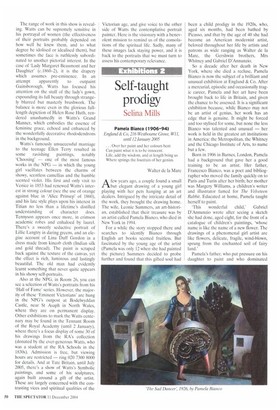Exhibitions 2
Self-taught prodigy
Selina Mills
Pamela Blanco (1906-94) England & Co, 216 Westboume Grove, W11, until 1 2 January 2005
. . . Over her paint and her colours bent Can paint what it is to be innocent. Life, add thy wisdom, and at length bring us Where springs the fountain of her genius.
Walter de la Mare A"wyears ago, a couple fond a small o when she had 12 w (Pamela was ad painted the picture) Summers decided to probe further and found that this gifted soul had been a child prodigy in the 1920s, who, aged six months, had been bathed by Picasso, and that by the age of 40 she had become an American modernist artist, beloved throughout her life by artists and patrons as wide ranging as Walter de la Mare, the Gershwin brothers, Mrs Whitney and Gabriel D'Annunzio. So a decade after her death in New York, where she died a recluse, Pamela Bianco is now the subject of a brilliant and unusual exhibition at England & Co. After a mercurial, episodic and occasionally tragic career, Pamela and her art have been brought back to life in Britain, and given the chance to be assessed. It is a significant exhibition because, while Bianco may not be an artist of genius, her work has an edge that is genuine. It might be forced and too stylised for some, but none the less Bianco was talented and unusual — her work is held in the greatest art institutions in America: the Metropolitan, the Whitney and the Chicago Institute of Arts, to name but a few. Born in 1906 in Barnes, London, Pamela had a background that gave her a good training to be an artist. Her father, Francesco Bianco, was a poet and bibliographer who moved the family quickly on to Paris and Turin after her birth; her mother was Margery Williams, a children's writer and illustrator famed for The Velveteen Rabbit. Educated at home, Pamela taught herselfto paint. 'This wonderful child,' Gabriel wrote after seeing a sketch D'Annunzio she had done, aged eight, for the front of a catalogue of children's paintings, 'whose name is like the name of a new flower. The drawings of a phenomenal girl artist are like flowers, delicate, fragile, wind-blown, sprung from the enchanted soil of fairy land.' Pamela's father, who put pressure on his daughter to paint and who dominated
much of her early career (and, ultimately, some say, caused her great nervous distress), was already promoting her in England by the time she was 12; her delicate and often eccentric drawings drew the press and crowds in droves to see her work. Her father wrote to her back in Italy that she was a great success, and that `soon you will be able to buy a house for all of us to go and live in'.
Unfortunately, Pamela never made enough money to achieve this dream for her family, let alone herself, but the Biancos did move back to England, and by 1920, when Pamela was 14, lived in Chelsea. The young girl with pigtails soon struck up a friendship with Walter de la Mare and collaborated on a book of his poems and her sketches called Flora. In the summers the family visited the poet Richard Hughes at Harlech in the Welsh hills, where they also got to know Robert Graves, William Nicholson and his family, including Ben Nicholson, whom she painted and sketched.
By 1921, with the ever-present pushy father, Pamela was offered her first show in New York, and was again feted as the child discovery of the new century. Again the family uprooted themselves and moved to the US, and her father opened a book store on 8th street, which artists such as ee cummings and the Gershwins frequented. And so the list of celebrities, including Helen Frick and Gloria Vanderbilt, continued and her career as a child artist soared.
With such an early thrust into the limelight, it is not surprising that, aged 20, Pamela suffered what would be the first of many severe mental breakdowns. What is surprising, however, is that despite these collapses she continued to paint, sketch and design, and even tolerated her father's continual requests for her to work. She managed to secure a Guggenheim Fellowship to study art in Europe for a year, where she found 'an extraordinary tranquillity' she had never found before.
She also married twice, had a muchloved son, Lorenzo, who died of cancer before she did, and moved from art to illustration to earn her living in her thirties and forties. She continued to correspond with Richard Hughes and Walter de la Mare, and carved out new friendships with artists such as Joseph Cornell. By her later years, her art had moved to extremely detailed and obsessively worked-on pieces, with links to Surrealism. But this style was going out of fashion — to the extent that a gallery, which had asked her to supply work for a retrospective, cancelled; she died telling her daughter-in-law to burn all the contents of her studio. Thankfully, her orders were not obeyed.
Pamela's story is an important one not only because of the catalogue of celebrities it includes, but also because it shows that child prodigies can have an afterlife. Often people who burn too brightly prematurely fall into the neglected gaps of history. But Pamela had an entirely new career as a modern artist and graphic designer in America. Thanks to the detailed research and presentation of this exhibition, what emerges is a fascinating story of a woman whose life stretched across the 1920s art and literary worlds of London and New York. She died with her work in prestigious collections. Hopefully, with this reappraisal, she will have a clearer and more defined place in the art world she so loved and admired.











































































 Previous page
Previous page